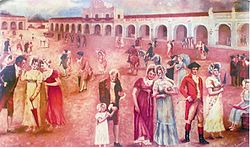Criollo people
The Criollos (singular: Criollo) were a social class in the caste system of the overseas colonies established by Spain in the 16th century, especially in Latin America. The word was used for people of pure or mostly Spanish blood, but who were born in the American colony.[1]
| Regions with significant populations | |
|---|---|
| Spanish colonial empire in the Americas | |
| Languages | |
| Spanish | |
| Religion | |
| Predominantly Roman Catholic |
The Criollo class was seen as lower than the Peninsulares. Peninsulares were the people who lived in the colony, but were born in Spain. Criollos had higher status/rank than all other castes. Other castes included people of mixed descent, Amerindians, and enslaved Africans.
The term Criollo is often translated into English as Creole. However, the word "creole" is also used for many ethnic groups around the world who have no historic connection to Spain or to any colonial system.
Criollos and the wars of independence
Until 1760, the Spanish colonies were ruled under laws designed by the Spanish Habsburgs. They gave the American provinces great independence. The situation changed with the Bourbon Reforms during the reign of Charles III.
Spain needed to get more money from its colonies for the European and global wars it was fighting so it could maintain the Spanish Empire. The Crown made the Penisulares more important, and they took over many administrative offices which had been filled by Criollos. At the same time, reforms by the Catholic Church reduced the roles and privileges of the lower ranks of the clergy, who were mostly Criollos.[source?]
By the 19th century, this loss of status led the Criollos to rebel against Spanish rule. The revolution was also inspired by the examples of the American and French revolutions against their kings. With increasing support of the other castes, they started to fight Spain in for independence (1809–1826).
Criollo People Media
A scene depicting many criollos at a soiree in the garden of Chapultepec, ca. 1780-1790, Museo Nacional de Historia, Chapultepec Castle, Mexico City.
Argentine caudillo Juan Manuel de Rosas, an example of a criollo of full-Spanish descent
The Spanish and their descendants born in America formed the highest social group in the colony. Drawing from the New Chronicle and Good Government by Felipe Guamán Poma de Ayala, 16th century.
Fermín Francisco de Carvajal Vargas, Duke of San Pedro. Creole born in the Kingdom of Chile
Image shows Venezuelan musicians performing Música llanera (música criolla).
The Fagoaga Arozqueta family. A colonial Mexican criollo couple of Spanish [basque] ancestry with their ten children in Mexico City, New Spain, anonymous painter, ca. 1735. Museo Nacional de San Carlos of Mexico City.
José Cecilio del Valle, born into a Criollo family from what is now southern Honduras in the city of Choluteca, he was a key figure of Central American independence and was a representative of Central America in Mexico City in 1822.
References
- ↑ Donghi, Tulio Halperín (1993). The Contemporary History of Latin America. Duke University Press. p. 49. ISBN 0-8223-1374-X.









